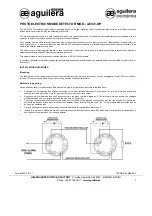
TESTING THE PANEL
When testing the panel with the panel lid open, always isolate the Mains and disconnect the batteries. The panel
can be tested before connecting field wiring. If testing before installation, ensure the end-of-line resistors are
fitted in the panel’s sounder and detector terminal blocks.
Position and connect two suitable 12V batteries in the panel as shown in Fig 3 and Fig 4 (page 1). When the
batteries are connected, the POWER SUPPLY FAULT indicator will light and the warning beeper will sound.
Connect the Mains wiring and turn the Mains supply on. The MAINS ON indicator will light, the POWER SUPPLY
FAULT indicator will go out and the warning beeper will silence (providing the batteries are not flat).
WITH THE KEYSWITCH AT NORMAL POSITION
The MAINS ON indicator is lit. No other indicators are lit. No sounders are active. The pushbuttons are inoperative.
TURN THE KEYSWITCH TO ARM CONTROLS POSITION
Note
: None of the panel’s pushbuttons are operative unless the keyswitch is in the ARM CONTROLS position.
Press RESET/RESOUND/TEST ZONE LAMPS. The ZONE FIRE and ZONE FAULT indicators light and the warning beeper
will sound. The MAINS ON indicator will remain lit. All the other indicators will NOT light. Release the pushbutton
and the panel will return to normal.
TEST THE POWER SUPPLY MONITORING CIRCUIT
Switch off the Mains. The POWER SUPPLY FAULT indicator will light, the MAINS ON indicator will extinguish, and
the warning beeper will sound. Press SILENCE FAULT SOUNDERS and the warning beeper will silence but the
POWER SUPPLY FAULT indicator will remain lit. Reconnect the Mains and the panel will revert to normal.
Disconnect the battery. The POWER SUPPLY FAULT indicator will light and the warning beeper will sound.
Reconnect the battery and after a short time the panel will revert to normal (i.e. only the MAINS ON indicator
light on). Note: This test should be carried out with a set of new and fully charged batteries – deteriorated cells
will show a fault even when connected and charged up.
TEST THE SOUNDER MONITORING CIRCUITS
DO NOT
carry out this test with the ZONE FIRE indicators lit as sounder fuses F2 & F3 could blow. Ensure the end-
of-line resistor is connected across each of the sounder circuits on terminals 5 & 6, 7 & 8. Short the sounder
terminals 5 & 6. The SOUNDER FAULT indicator will light and the warning beeper will sound.
Press SILENCE FAULT SOUNDERS and the warning beeper will silence but the SOUNDER FAULT indicator will stay
on. Remove the short and the panel will revert to normal. Open circuit the sounder terminals 5 & 6 by
disconnecting one leg of the end-of-line resistor. The SOUNDER FAULT indicator will light and the warning beeper
will sound. Press SILENCE FAULT SOUNDERS and the warning beeper will silence but the SOUNDER FAULT indicator
will stay on. Remake the circuit and the panel will revert to normal.
Repeat the test for the other sounder circuit via terminals 7 & 8.
TEST THE DETECTOR MONITORING CIRCUITS
Make sure an end-of-line device (EOLD) is connected across each pair of detector terminals (9 & 10, 11 & 12, etc.).
The EOLD would either be a 6.8k
Ω r
esistor or Electronic Monitoring Unit (EMU) and associated Panel Module,
depending on the installation. Refer to Fig 5 (page 1) & EMU instructions for connections.
The following four conditions can exist on the detector monitoring circuits:
1. Normal Condition:
Current flows round the detector loop via the EOLD to monitor the wiring.
2. Open Circuit Fault:
The wiring is broken at some point and the monitoring current cannot flow through the EOLD.
3. Short Circuit Fault:
A short circuit exists at some point and too much monitoring current flows.
4. Fire Condition:
A partial short exists and the monitoring current increases but not enough to show a short circuit
fault. Most smoke detectors make a partial short when they are triggered but manual call points and other
normally open switches need to have 470 or 680
Ω
resistors connected in series in order to give a partial short.
(Check - Resistor may be built into the Call Point - see Fig 5, page 1.)
OPEN CIRCUIT FAULT TEST
Open circuit the zone circuit terminals (9 & 10) by disconnecting one wire of the EOLD. The ZONE 1 FAULT
indicator and internal ZONE 1 OPEN CIRCUIT FAULT indicator will light. The warning beeper will also sound. Press
SILENCE FAULT SOUNDERS and the warning beeper will silence but the indicators will stay on. Reconnect the EOLD
and the panel will revert to normal.
SHORT CIRCUIT FAULT TEST
Short circuit the zone circuit terminals (9 & 10). The ZONE 1 FAULT indicator and internal ZONE 1 SHORT CIRCUIT
FAULT indicator will light. The warning beeper will also sound. Press SILENCE FAULT SOUNDERS and the warning
beeper will silence but the indicators will stay on. Remove the short and the panel will revert to normal.
Repeat the test for the other zone circuit via terminals 11 & 12.
FIRE CONDITION
Simulate a Fire condition by connecting and activating a Call Point, or by fitting a 470 to 680
Ω
resistor across
terminals 9 & 10. The sounder output relay will operate. The ZONE 1 FIRE indicator lights and warning beeper sounds.
Press SILENCE ALARM SOUNDERS. The sounder outputs return to normal but the ZONE 1 FIRE indicator will still be lit
and the warning beeper will still sound. Press RESET/RESOUND/TEST ZONE LAMPS and the panel will go back into
alarm as the Fire condition is still present. Remove the Fire condition. Press SILENCE ALARM SOUNDERS, then
RESET/RESOUND/TEST ZONE LAMPS, and the panel reverts to normal. Repeat the test for the other zone terminals.
FIRE ALARM
ancillaries
2 of 4
Approved Document No. DFU0388010 Rev 2





















